How to Charge AirPods Without a Case
Discover the truth about how to charge AirPods without a case. Uncover myths, find alternatives, and safeguard your audio experience.
For most people, it only takes a playback device, a favorite collection of music and a pair of headphones to get the best listening experience. While this basic setup is all one needs, sometimes adding a headphone amplifier plays a huge role in the overall audio quality output. For some people getting a headphone amp is necessary, but how do you know if you need one?
In this article, I will be discussing more about headphone amplifiers, and why you should or should not get one.
So, sit back and relax because you have come to the right place!
This is not going to be a long article but, by the time you are through reading, you should have an idea of what a headphone amp is, how it works and be in a state to decide if you require one for your headphone or not.
Below are the topics I will be covering in this article,
Without wasting much time let us get into this!
An amplifier is a device that simply increases a low voltage audio signal from a playback device (a smartphone, turntable, or home theatre) to better and sufficient levels that can drive bigger equipments. Most of the times, amplifiers are used to power bigger speaker or in the case of concerts to make the equipments louder.
A headphone amp uses the same concept as the amps used to power bigger speakers, but it is much smaller. The smallest headphone amp that I believe to be the AudioQuest DragonFly v1.5 is the size of a flash drive while the largest are around the size of a PC DVD-ROM drive.
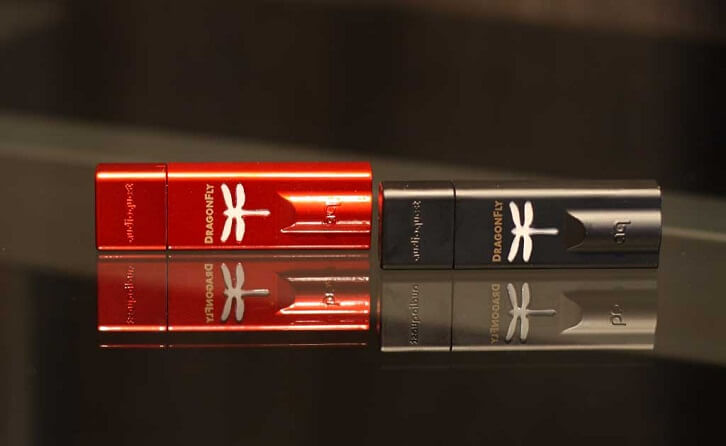
AudioQuest DragonFly v1.5 USB DAC and Headphone amplifiers, Red & Black | HiFiVoice.com
Because of their size, most people might think headphones are easier to drive compared to other equipment. After all, a pair of headphone consists of just miniature speakers that do not need much power. While this true to some extent, it also depends on the playback device you are using to power the headphone, be it a Smartphone, Mp3 player, PC or a tablet.
You might think a pair of headphone is easy to power, but using a smartphone, tablet, or MP3 player will not provide enough power to drive high-end headphones.
This led us to why in the first place you need a headphone amplifier (see also headphone amp under $500 here). If you use your smartphone, Mp3 player, tablet or a portable playback device with your headphones, you might need an amp. Of course, this will depend on several factors but like all speakers, if the power feed to your headphones is not enough to drive them, they will not go off like other electronics, and instead, they will sound quiet with certain aspects of audio such as the bass lacking a punch.
Therefore, if your headphones sound quieter than normal, then an amplifier might just do the trick. You can also check out this article on other different ways to make your headphones louder.
The headphone’s impedance rating can give the power needed to drive a pair of headphones.
Some headphones do not require a headphone amp to sound good. These are low impedance headphones. The higher the headphone’s impedance, the lower the volume and quality of audio will be if you are driving them at low power.
Headphone Impedance, measured in ohms (Ω), refers to the resistance of an electrical signal as a result of the headphone’s voice coil and the magnetic field coupling of the voice coil plus the magnet.
Simply put, the higher a headphone impedance number, the more resistance a headphone or speaker will offer to an electrical signal.
The impedance in headphones can vary from as low as 8 ohms and some of them to as high as 600 ohms. There are some however with insanely high impedance values such as the classic Sennheiser HD 424 at 2000 ohms.
If you are, planning to buy or you currently own a headphone with high impedance value, then an amp is necessary to get the best out of that headphone.
Older headphones such as the DT880 at 600 ohms or the HD800 at 300 ohms were meant to be used with powerful audio gear. Without amplification, headphones that come with high impedance values will not play at the desired volume level, and possibly the audio quality will be lower. Modern headphones such as the Audeze LCD2C (70 ohms) or the Focal Clear (55 ohms) also require headphone amps to work properly.
However, not all high-performance or high-end headphones come with high impedance values. With more people using smaller audio sources such as Mp3 players or smartphones, headphone manufacturers and designers have also adjusted. HiFiMAN’s HE400S (22 ohms) and Phillips X2/27 Fidelio (30 ohms) are great examples.
In-ear headphones mostly come with lower headphone impedance values and will work fine with most portable playback devices.
Generally, as a rule, I use a headphone amp for cans that are above 32 ohms. Any headphone below this value works just fine with or without an amp.
Apart from the power requirements, impedance values are another reason you would consider a dedicated headphone amp would be to improve the sound quality.
If you want to know if a 4 Ohm speaker is better than an 8 Ohm speaker, we made an article comparing the two.
Though amps most people advocate the use of headphone amps, there are some situations where the use would not result in a significant difference.
First, the use of an amplifier with active noise-canceling headphones or in this cases any headphone that comes with its built-in amplifier.
Another scenario where a headphone amp would not be recommended is when using the amp with high or very high sensitivity in-ear headphones.
With high sensitivity, it will be easy enough for in-ear headphones to achieve your desired volume levels.
However, low impedance headphones (16-32 ohms) would benefit from a headphone amplifier with higher current output aiding to improve the damping factor.
External DACs (Digital-to-Analogue-Converters) until recently were not common, they were reserved for music studios and audiophiles. DACs are built-in in every digital playback device (PC, smartphones, Digital audio player and much more), so, what is a DAC and how would it benefit you?
A DAC (see a list of DACs under 200 here) is a device that takes the digital data (ones and zeros) and transforms the data to analog audio signal.
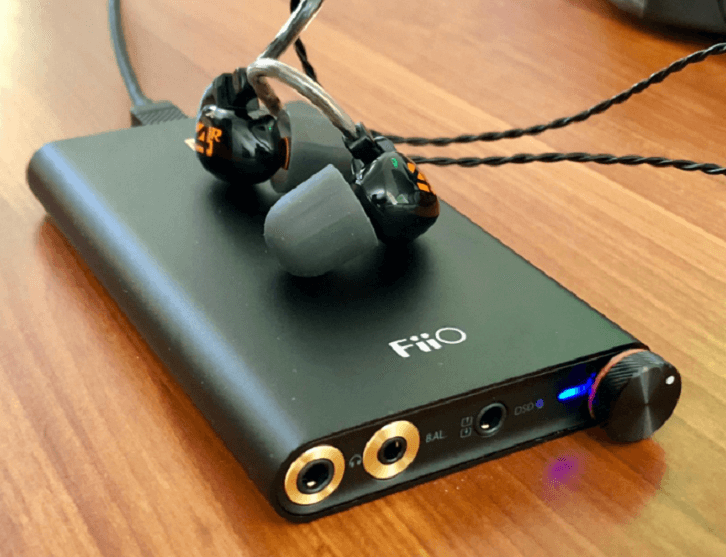
FiiO Q1 Mark II DAC and Westone W4R Headphones | Sound Gear Lab
Because most devices come with a built-in DAC, one would question why you need an external DAC.
But, here is the thing – not all DACs are created equally. Compared to a built-in DAC, an external DAC decodes digital audio with greater precision than the one in your digital music player creating a better audio foundation for other pieces of equipment. Add a headphone amplifier to the mix, and you will be in for some great listening music sessions.
Luckily, most headphone amps come with DACs installed already and if you wish to get better sound quality, external DACs are now available, and you get one without much hassle.
There are three types of headphone amps; tube amps, solid-state amps, and hybrid amps. Choosing which one to get majorly depends on the kind of sound you want. The important thing is to test each type of amp yourself and determine what sounds right to you.
Tube amps are one of the first technologies in amplifiers and use vacuum tube/s to process audio signals from a play device. Some examples of this type of amp would be the Bravo Audio V2. Feliks Elise MkII or Woo Audio WA7. Tube amps have come a long way even surviving into the modern days.
Even with the downsides that come with tube technology, to some tube amps still offer better and richer sounds than solid-state alternatives, but that is for you to decide.
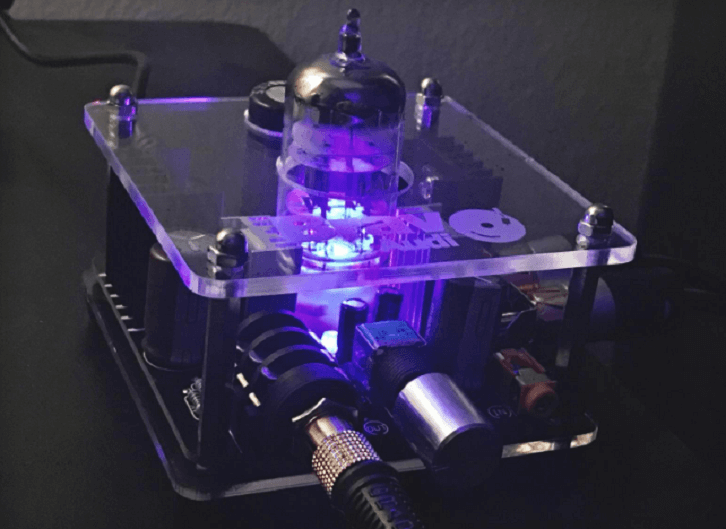
Bravo Audio V2 Tube amp | Sound Gear Lab
In modern times, solid-state amps have become more common. This type of amp is popular and favored by most people because they are smaller (portable), cheaper and more reliable.
Though there are modern tube amps that are portable, solid state amps are the best if you need an amp you can move around with easily. A good example of a pocket-sized portable headphone amp would be the JDS Labs the Element.
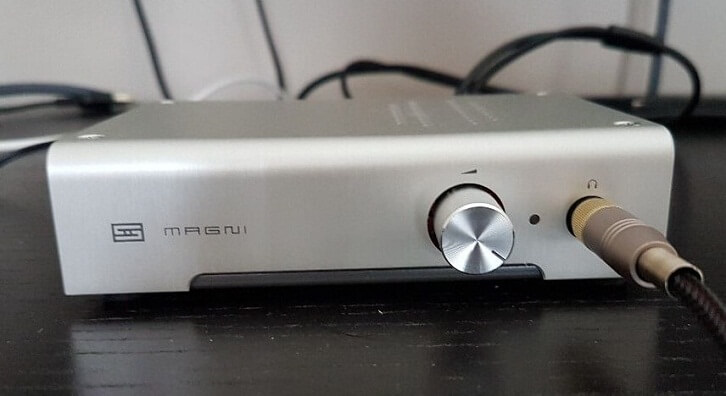
The Schiit Audio Magni 3 is one of the Best Headphone amplifier | Sound Gear Lab
Hybrid amps use both of the above amp technologies. Normally hybrid amps rely on tubes to give the music more color and warmth and electronics to provide the power needed to power them efficiently.
A great example of a hybrid amp would be the Schiit Mjolnir 2 and Schiit Magni 3+.
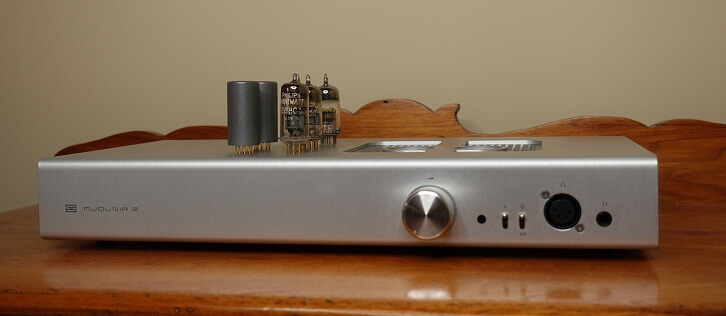
Schiit Mjolnir 2 Hybrid amp | Sound Gear Lab
Which headphone amplifier should I pair my headphones with? This is the one question most people ask before buying a headphone amplifier. There are a few guides that can help you choose the right amp for your headphones, but overall this boils down to your personal choice.
One of the most important factors to look out for when looking for a headphone amplifier is the impedance matching. Like with headphones, amplifiers too come with impedance rating which constitutes the inductance, resistance, and capacitance to the current generated by a headphone.
For better performance, matching the impedance of your headphones to that of your amplifier is key. Impedance matching does not mean selecting an amp with the same impedance as your headphone.
An easy and fast way to calculate headphone to amplifier compatibility is to use the rule of eighths.
This means taking the impedance of the headphone and dividing it by eight. The number you get after the calculations is the approximate maximum impedance output you would look for when selecting your amplifier.
Here is an example
| Headphone impedance | Rule of Eights | Max. amp impedance |
|---|---|---|
| 32 ohms | 1/8 | 4 ohms |
What happens when you ignore the rule of eights?
Well, am glad you asked. Three things might occur, first, if the amp’s impedance output is much greater than an eighth of the headphone’s impedance, then the sound quality and frequency response could be altered. Second, there will be higher chances of electrical damping (dynamic headphones) affecting the overall sound signature of the headphone. Third, there will be an increase in unwanted sound, usually, a hissing sound. This is especially popular with balanced armature drivers.
So, there you have it, I hope this article helps you to decide if you need an amp and how to choose one for your headphone.
If you enjoyed reading, please comment below. You can also ask questions, and I will answer them to the best of my knowledge.